If you have limited space for a garden or want something more accessible and lower maintenance than a traditional garden, raised beds may be the answer. Raised bed gardening involves growing plants in soil higher than the natural ground level, often enclosed by some sort of frame. There are many different types of raised garden beds, ranging from store-bought kits to homemade upcycled frames.
Raised bed gardening offers many benefits. Using square-foot gardening techniques, you can grow more plants in less space. And closely spaced plants combined with fresh soil also mean fewer weeds. Higher raised beds reduce the need to bend over and thus lessen the likelihood of back pain.
When planning your raised garden beds, consider location, size, appearance, functionality, and budget. If you want to grow vegetables, for instance, the beds should be placed in a location where they will receive at least eight hours of sunlight every day. We’ve compiled the following list to help get you started.
1. Metal Raised Garden Beds
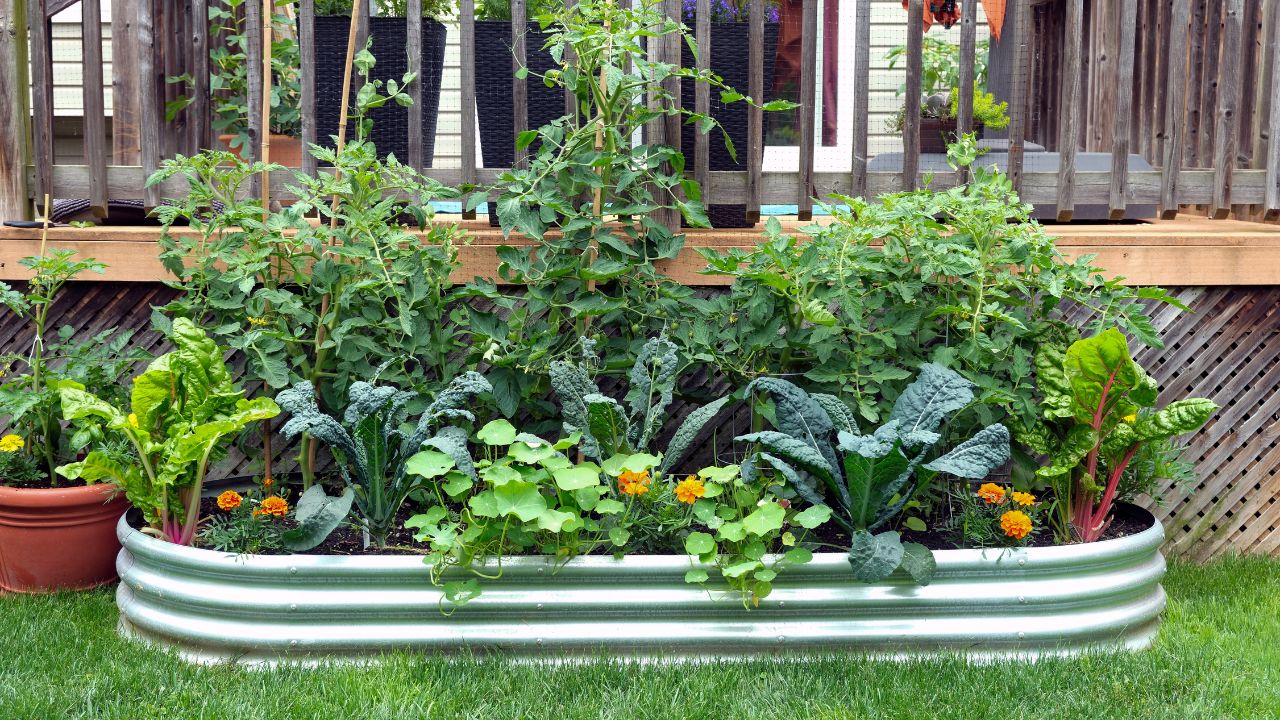
Image Credit: Shutterstock.
While the soil in all raised beds heats up faster in the spring, because it sits above the frost line, metal frames especially help retain heat. This makes them great for Mediterranean plants like sage or lavender. Sheet metal can also be formed into specific shapes, giving you greater creative liberty beyond the usual rectangle.
One downside of this is that the metal can be a bit flimsy and bow in the middle, but proper support in the form of a wood frame or metal conduits and corner supports can help. A supported raised bed made with the latter option and galvanized steel panels can last 30 to 60 years!
2. Plastic Raised Garden Beds

Image Credit: Shutterstock.
High-density polyethylene (HDPE) recycled plastic raised beds also last a long time, with a life expectancy of about 50 years. They’re also resistant to cracking or chipping due to extreme weather or, say, accidentally ramming them with a wheelbarrow. A stable material, HDPE is not known to leach any chemicals into the soil, so it should be safe for vegetables and herbs.
As far as appearance is concerned, plastic raised garden bed frames can be purchased in a variety of colors, and some are even made to look like wood. They’re easy to clean and when the time comes to dispose of them, recyclable. Unfortunately, HDPE can be expensive and heavy yet prone to bowing.
3. Elevated Cedar Raised Garden Beds

Image Credit: Deposit Photos.
An elevated raised garden bed resembles a table with legs or a very deep box, making the plants within easy to maintain without kneeling or bending over. Since it’s up high, it also keeps critters like rabbits, moles, and groundhogs out of your garden (though you may still have to fight off the squirrels!).
The benefits of using cedar for an elevated raised garden bed include its beautiful, natural appearance and resistance to decay. It’s also lightweight and, if you’re building the raised bed yourself, easy to work with.
Cedar will turn a silvery gray within two or three years, though it will continue to last for up to a decade, depending on your climate. A natural exterior finish can be applied before filling the bed with soil to prevent it from fading if you desire.
4. Other Wooden Raised Garden Beds

Image Credit: Shutterstock.
Of course, cedar and other types of wood can be used for many different raised garden bed designs. Redwood is another attractive and rot-resistant option, and all types of wood make beautiful, rustic frames for raised garden beds. If you’re looking for a natural option, wood is a great way to go.
One thing to note is that you should never use pressure-treated lumber for raised garden beds. Although it will hold up longer than untreated wood, it can leach harmful chemicals into the soil and thus into your vegetables, herbs, and other plants. This does mean that you will have to repair or replace the raised bed frames more often, but some types of untreated wood, like cedar and redwood, can last up to ten years.
5. Composite Raised Garden Beds
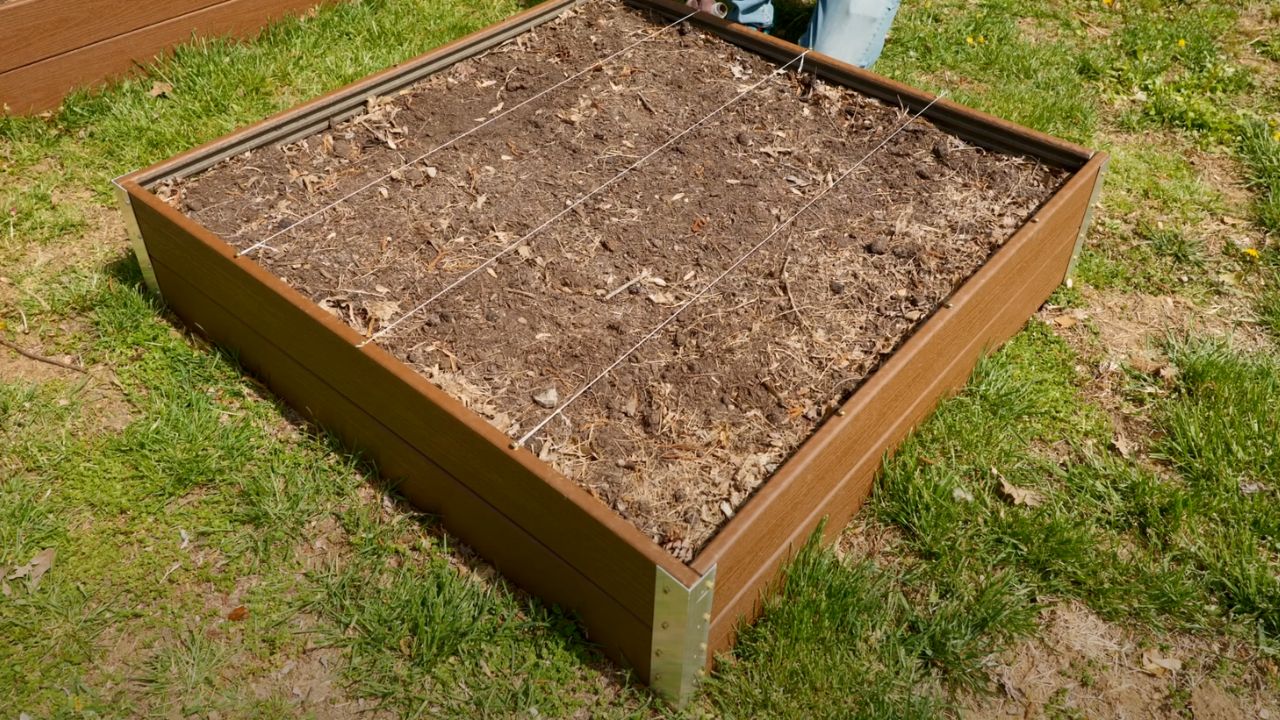
Image Credit: I Like To Make Stuff/Wiki Commons.
Composite “lumber” is made of a mixture of materials such as wood and plastic. At a glance, it looks just like natural wood with its wood-grain imprint. It’s also lightweight, weather and rot-resistant, and easy to clean. However, composite raised garden beds can be easily damaged by a wayward shovel or string trimmer and might bow outward or fade over time.
Many composite raised garden beds are made with recycled materials, and they often come with hinged corner joints, making them easy to assemble and reconfigure. Curved boards are also available for even more design options.
Unique Ways To Build Raised Garden Beds On A Budget

Image Credit: Deposit Photos.
If a premade kit sounds too pricey, there are plenty of ways to build raised garden beds with free or cheap items. You can even get creative with the soil: buying bags of garden soil can be expensive! If your raised beds will be directly on the ground, remove any weeds and dig up a few inches of the topsoil. Lay down cardboard as a weed barrier, then cover it with layers of topsoil, compost, shredded leaves, composted manure, straw or old hay, etc (called the lasagna gardening method).
6. Raised Bed Gardening with Pallets
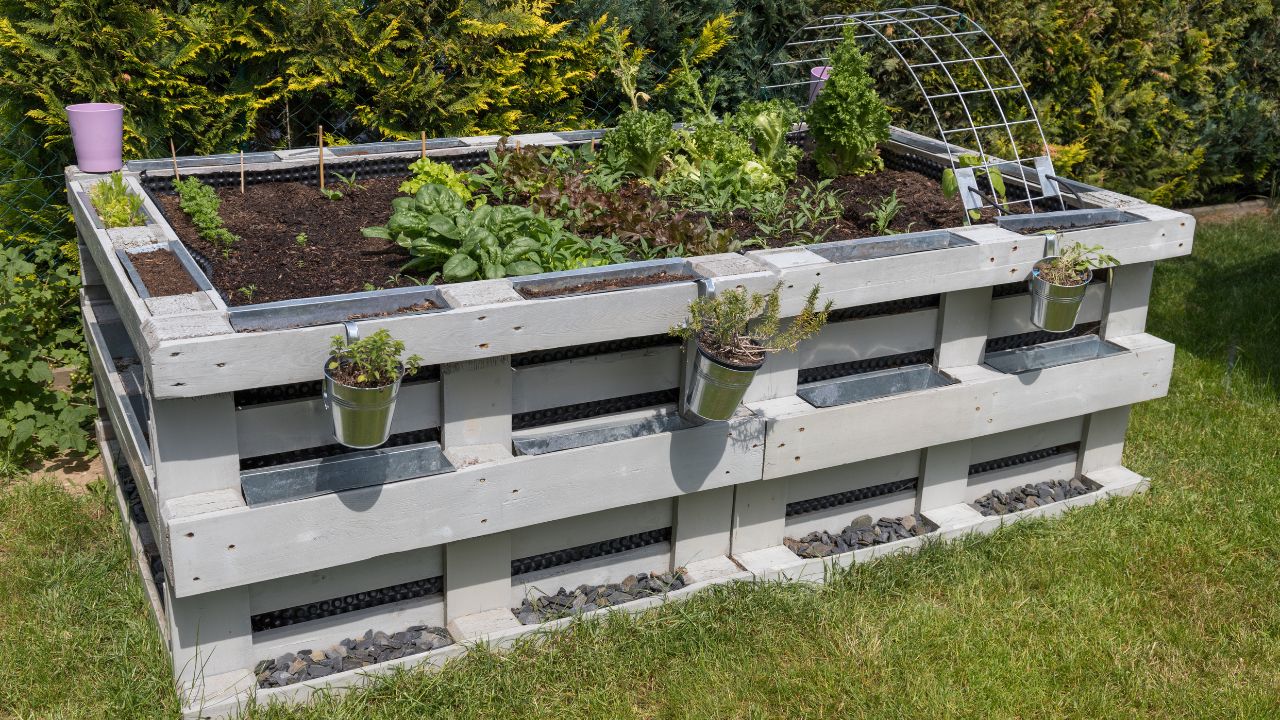
Image Credit: Shutterstock.
Pallets are wonderfully versatile and can often be found for free. Make sure the pallets you pick up or purchase are heat-treated; they should have “HT” stamped somewhere. This means that the wood was kiln-dried rather than chemically treated. You’ll also want to scrub the pallets down well to ensure there are no harmful residues left over from whatever was previously stored on them.
There are two primary ways to make a raised bed out of pallets: by taking them apart and building traditional box frames or by planting directly in them. For the latter, simply lay the pallets down faceup, fill them with dirt, and plant between the wood slats.
You can also wrap the bottom and sides in landscaping fabric (secured with staples) to help keep the soil in place. Or try surrounding the pallets with concrete blocks: these double as planters that can be filled with strawberries, marigolds, or herbs.
7. Raised Bed Gardening with Straw Bales
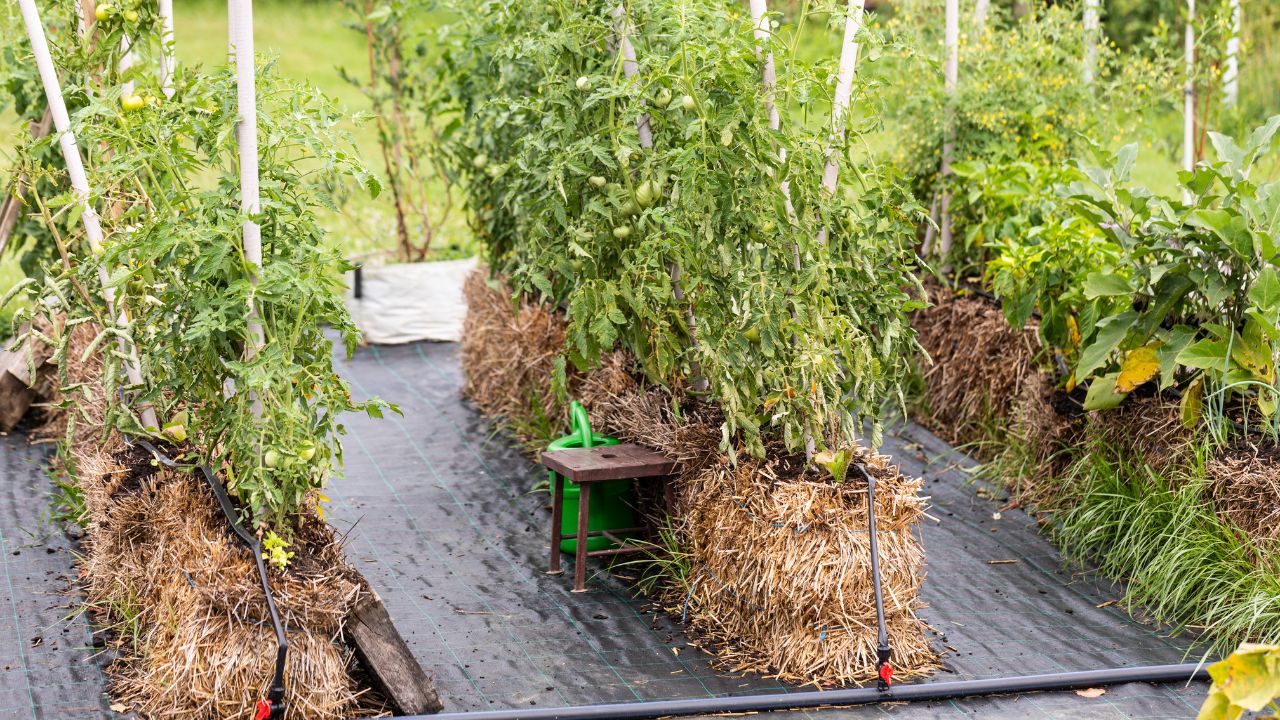
Image Credit: Shutterstock.
As with pallets, there are two ways to make raised beds with straw bales. First, you can arrange the bales into a frame to hold soil like a traditional raised bed. Or simply plant directly into the bales themselves! For this second method, you’ll need to prep the bales about two weeks in advance by adding fertilizer every couple of days and watering them. This encourages the straw to begin breaking down and forming a growing medium for your plants.
Strawbale gardens lend themselves well to trellising, and you can simplify watering by laying a soaker hose down a row of bales. At the end of the growing season, the partially decomposed straw works great as mulch for other garden beds or as compost for next year. You can also do raised bed gardening with hay bales, but you might get some weeds from the seeds in them: this isn’t typically a huge problem, though.
8. Raised Bed Gardening with Old Tires
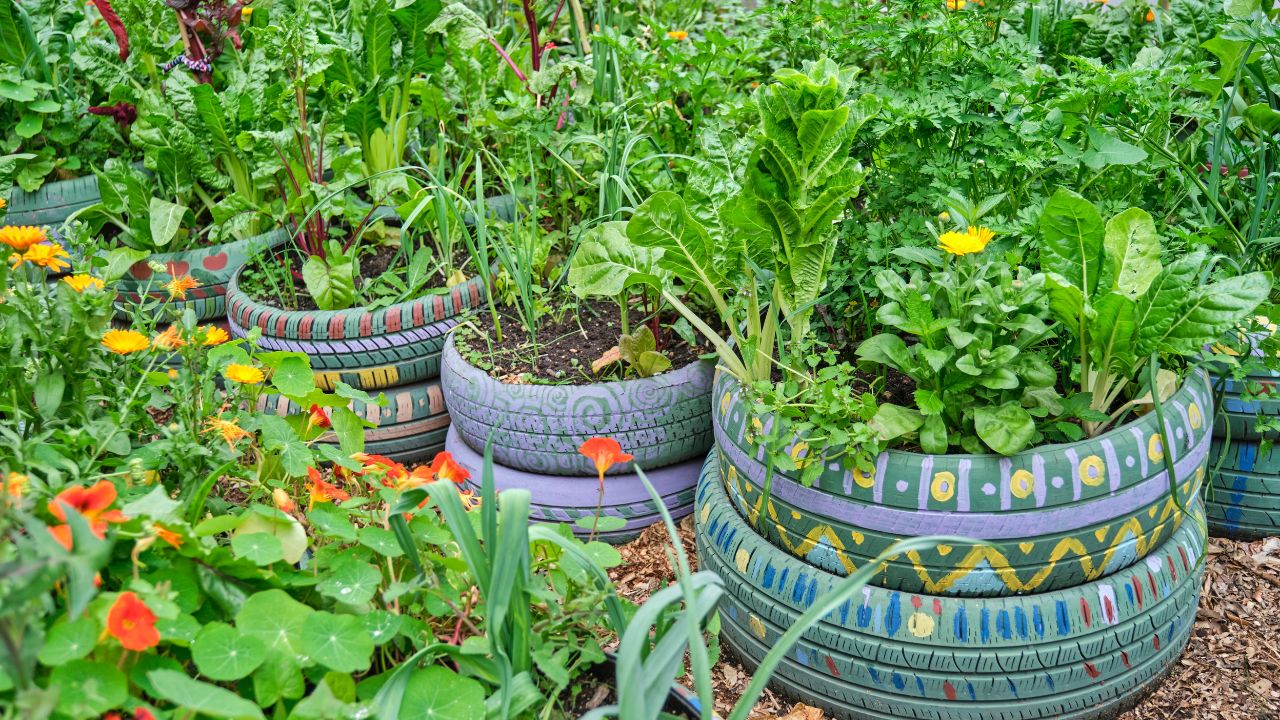
Image Credit: Shutterstock.
Using old tires to create raised bed planters is extremely easy, and it’s a great way to upcycle something that’s no longer needed. Just place the tires where you want your garden and fill each one with soil: that’s it! And because tires heat up quickly and warm up the soil sooner in the spring, you can get started planting earlier. For the same reason, plant heat-loving crops in tires and put the cool-season veggies elsewhere.
One major concern with gardening with old tires is chemical leaching. Some studies suggest that these toxic materials are released slowly enough to be negligible, but better safe than sorry, right? Use old tires only for ornamental plants or line them with plastic or landscape fabric before adding soil if you want to plant vegetables in them.
9. Raised Bed Gardening with Milk Crates
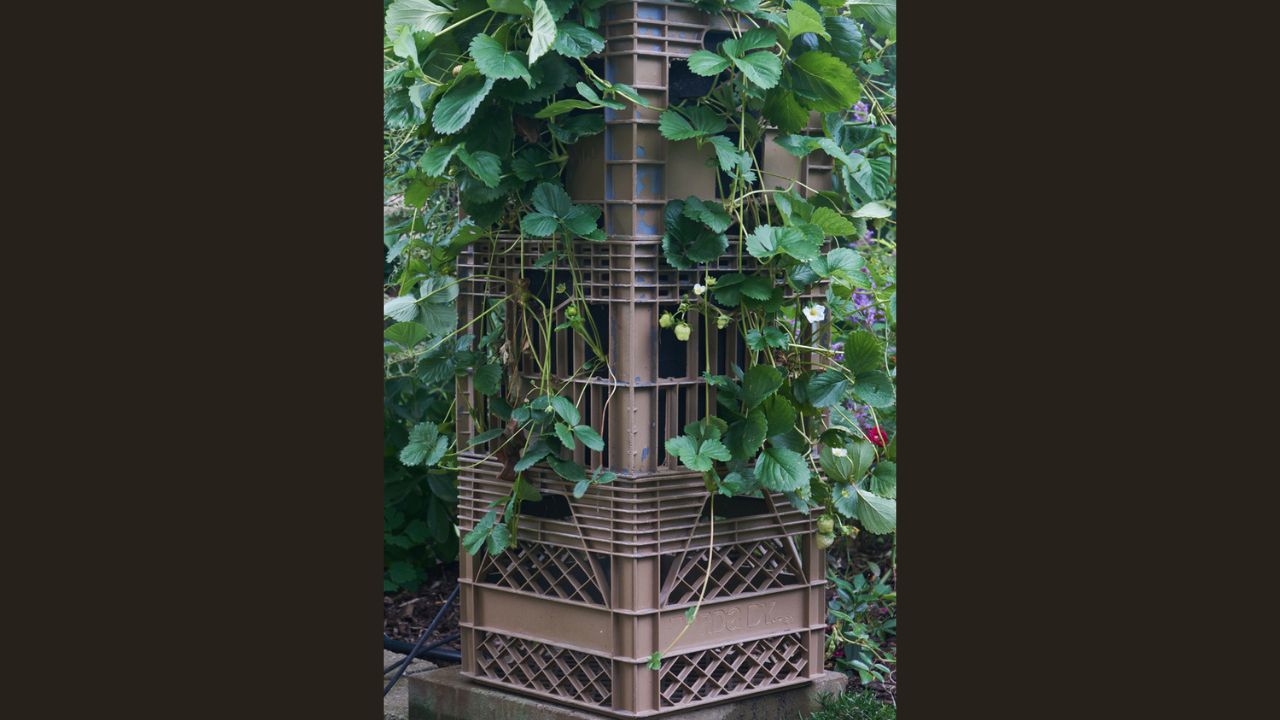
Image Credit: Deposit Photos.
Milk crates are a fun, versatile way to garden in a small space. They can be lined up in a single layer, stacked checkerboard or stair style, or even used as hanging planters! To keep the soil from spilling out the holes, line each milk crate with burlap before filling it with soil. Plastic also works, but make sure to poke plenty of small holes for water drainage.
Because they’re smaller, milk crates typically hold only one vegetable or herb each, with the exception of smaller plants like lettuce and carrots. You can even use cardboard to line only the bottom of the crate, instead of burlap, and plant strawberries or small herbs or flowers through the holes in the sides. Of course, this works best with crates that have exceptionally large holes.
Frequently Asked Questions About Raised Garden Beds
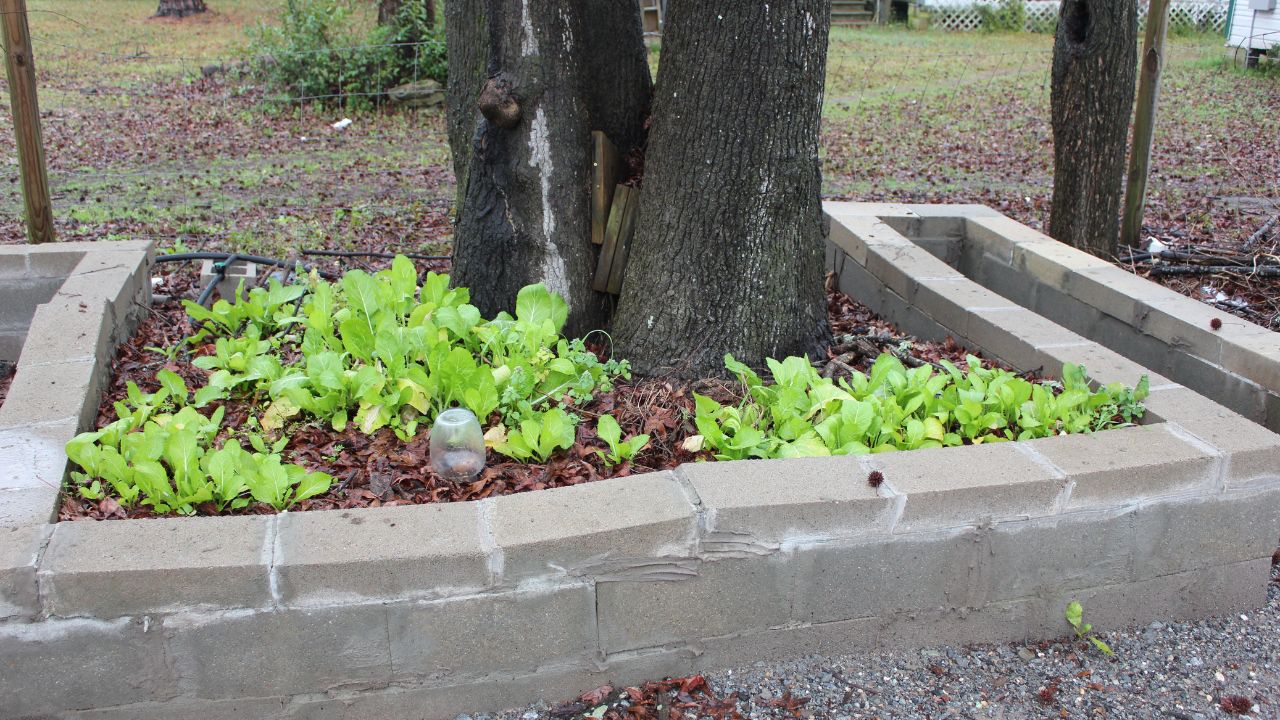
Image Credit: Shutterstock.
Can you explain how to use raised beds in landscape design?
The first thing to keep in mind is that even when you’re working with individual raised beds, a garden is not a series of unrelated parts but rather an interconnected whole. Make sure the proportions of your beds match the space and use materials and shapes that fit with the overall aesthetic of your garden. Leave at least 18 inches between the beds for walking paths, or wider for wheelbarrow access.
If you have existing raised beds that aren’t very attractive, try painting the exterior or bordering them with willow screening.
What are the benefits of raised bed gardening?
Raised beds often warm up earlier in the spring and have fewer weeds, and their elevated design prevents back pain caused by bending and kneeling. They can also be installed in areas where you wouldn’t otherwise be able to have a garden due to space limitations, lack of soil, or poor growing conditions.
What’s the best soil for raised garden beds?
One of the simplest, best combinations for raised garden bed soil is a mixture of one part compost (plant or animal-based) and one part topsoil. Some people swear by coconut coir, which helps aerate the soil as well as retain nutrients and moisture. This can make up as much as one-third to one-half of the soil mixture. Worm castings and other organic amendments are also great additions to ensure bountiful results.
Can a raised bed be installed on a concrete surface, such as a patio?
Absolutely! One of the great things about raised beds is that they can be installed almost anywhere. To ensure healthy soil, you may want to introduce earthworms to the garden beds since they won’t be able to enter from the ground as they normally would.
Think outside the box
Raised bed gardens aren’t a one-size-fits-all deal. Shop around a bit, consider what you have on hand, and choose an option that works best for you. Maybe a few plastic milk crates will stack perfectly in a corner of your balcony, or perhaps you have a large backyard with space for several wooden frames. Try building an octagonal herb garden in the center for a functional visual display or combining several different types of raised beds in your garden. The possibilities are endless!

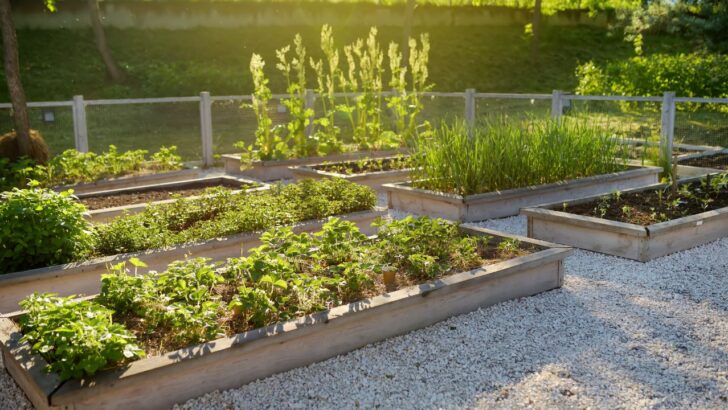

9 Patio Garden Ideas To Transform Your Outdoor Living Space
Thursday 10th of August 2023
[…] Raised beds also work well for flowers and enable you to keep contained plants that spread a little too eagerly. Plus, they keep your plants at an easily accessible height, reducing the need to bend and kneel. […]
How And Why You Should Grow Food Not Lawns
Thursday 3rd of August 2023
[…] can also build raised garden beds on top of the cardboard and fill in the space around them with gravel or bark mulch and stepping […]
13 Fun Landscaping Ideas Around Trees
Thursday 22nd of June 2023
[…] You can build a basket or wall around the base of the tree and add a raised garden bed for a unique look and smart use of the space. A raised bed will avoid the tree’s roots but still give you a place to plant any kinds of flowers or plants you want. You can even keep it very simple and plant grass on your raised garden bed. […]
10 Thrifty Landscaping Ideas For Every Budget
Saturday 6th of February 2021
[…] For low-maintenance vegetable gardening, grow your favorite seasonal vegetables in attractive raised beds, and plant perennials like rhubarb, bunching onions, or sorrel among your flower […]
Step Up Your Landscape Design With Attractive Garden Path Ideas
Tuesday 27th of October 2020
[…] raised garden beds with gravel (remember to lay down landscaping fabric first!) for a low-maintenance backyard; […]